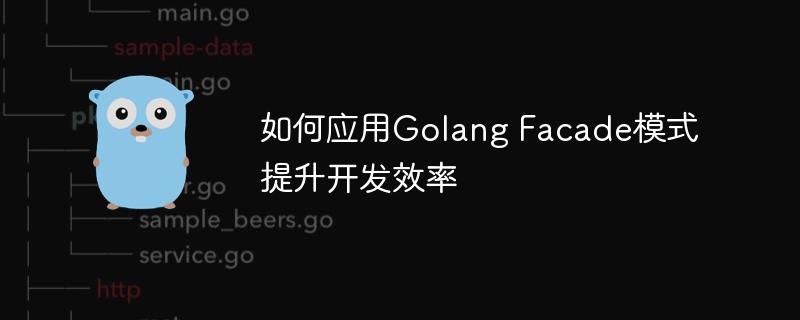Home >Backend Development >Golang >How to apply Golang Facade pattern to improve development efficiency
How to apply Golang Facade pattern to improve development efficiency
- WBOYWBOYWBOYWBOYWBOYWBOYWBOYWBOYWBOYWBOYWBOYWBOYWBOriginal
- 2023-09-28 17:17:10762browse

How to apply Golang Facade pattern to improve development efficiency
Overview:
In software development, we often encounter complex systems or libraries, of which there are many Cumbersome steps and complex interfaces. In order to improve development efficiency and reduce coupling, we can use the Facade pattern in the design pattern. This article will introduce how to apply the Facade pattern in Golang and provide specific code examples.
What is the Facade pattern:
The Facade pattern is a structural design pattern that provides a simplified interface for better use of complex systems or libraries. It hides the complexity of underlying components and encapsulates them behind a unified interface, making it easier for clients to use them.
Applying the Facade pattern in Golang:
The key to implementing the Facade pattern in Golang is to create a middleware that encapsulates the underlying components and provides a simplified interface for clients to use.
The following is an example, assuming we have a complex system consisting of multiple subsystems: SubSystemA, SubSystemB and SubSystemC. Each subsystem has some independent methods, but the interaction between them is complex. We will use the Facade pattern to encapsulate these subsystems and provide a simple interface to the client.
First, we need to define the interface and implementation of the subsystem:
// SubSystemA 子系统A的接口
type SubSystemA interface {
MethodA()
}
// subSystemA 子系统A的实现
type subSystemA struct {
// 子系统A的一些属性
}
func (s *subSystemA) MethodA() {
// 子系统A的具体实现
}
// SubSystemB 子系统B的接口
type SubSystemB interface {
MethodB()
}
// subSystemB 子系统B的实现
type subSystemB struct {
// 子系统B的一些属性
}
func (s *subSystemB) MethodB() {
// 子系统B的具体实现
}
// SubSystemC 子系统C的接口
type SubSystemC interface {
MethodC()
}
// subSystemC 子系统C的实现
type subSystemC struct {
// 子系统C的一些属性
}
func (s *subSystemC) MethodC() {
// 子系统C的具体实现
}Next, we create a middleware, the Facade interface and implementation:
// Facade 统一的接口
type Facade interface {
DoSomething()
}
// facade Facade接口的具体实现
type facade struct {
subSystemA SubSystemA
subSystemB SubSystemB
subSystemC SubSystemC
}
func (f *facade) DoSomething() {
// 使用子系统的方法,并协调它们之间的交互
f.subSystemA.MethodA()
f.subSystemB.MethodB()
f.subSystemC.MethodC()
}Finally, we You can use the Facade interface on the client to operate complex systems, as shown below:
func main() {
subSystemA := &subSystemA{}
subSystemB := &subSystemB{}
subSystemC := &subSystemC{}
facade := &facade{
subSystemA: subSystemA,
subSystemB: subSystemB,
subSystemC: subSystemC,
}
// 使用Facade来执行操作
facade.DoSomething()
}Through the Facade mode, we encapsulate the complex system in a middleware and provide a simplified interface for the client to use . The advantage of this is that the client no longer needs to understand and manage the underlying subsystem, but only needs to call the methods provided by the Facade. This not only improves development efficiency, but also reduces system coupling. When the underlying subsystem becomes more complex, we only need to modify the Facade implementation without affecting the client code.
Summary:
This article introduces how to apply the Facade mode in Golang to improve development efficiency. By encapsulating the underlying system in a middleware, we can provide a simple interface for clients to use. This not only improves development efficiency, but also reduces the coupling of the system. I hope this example can help you better understand and apply the Facade pattern.
The above is the detailed content of How to apply Golang Facade pattern to improve development efficiency. For more information, please follow other related articles on the PHP Chinese website!

